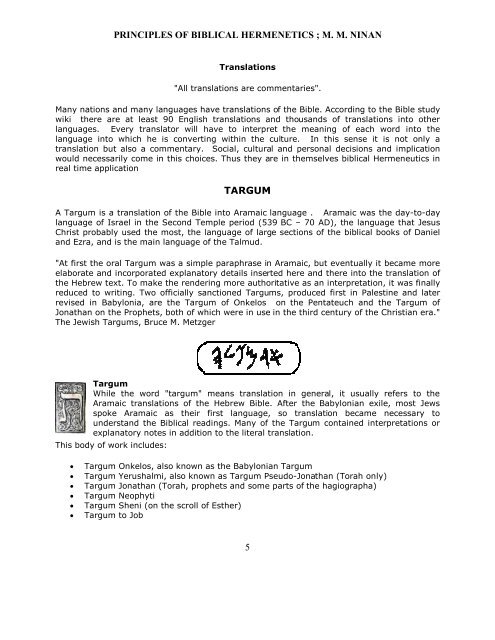Biblical Hermeneutics
You also want an ePaper? Increase the reach of your titles
YUMPU automatically turns print PDFs into web optimized ePapers that Google loves.
PRINCIPLES OF BIBLICAL HERMENETICS ; M. M. NINAN<br />
Translations<br />
"All translations are commentaries".<br />
Many nations and many languages have translations of the Bible. According to the Bible study<br />
wiki there are at least 90 English translations and thousands of translations into other<br />
languages. Every translator will have to interpret the meaning of each word into the<br />
language into which he is converting within the culture. In this sense it is not only a<br />
translation but also a commentary. Social, cultural and personal decisions and implication<br />
would necessarily come in this choices. Thus they are in themselves biblical <strong>Hermeneutics</strong> in<br />
real time application<br />
TARGUM<br />
A Targum is a translation of the Bible into Aramaic language . Aramaic was the day-to-day<br />
language of Israel in the Second Temple period (539 BC – 70 AD), the language that Jesus<br />
Christ probably used the most, the language of large sections of the biblical books of Daniel<br />
and Ezra, and is the main language of the Talmud.<br />
"At first the oral Targum was a simple paraphrase in Aramaic, but eventually it became more<br />
elaborate and incorporated explanatory details inserted here and there into the translation of<br />
the Hebrew text. To make the rendering more authoritative as an interpretation, it was finally<br />
reduced to writing. Two officially sanctioned Targums, produced first in Palestine and later<br />
revised in Babylonia, are the Targum of Onkelos on the Pentateuch and the Targum of<br />
Jonathan on the Prophets, both of which were in use in the third century of the Christian era."<br />
The Jewish Targums, Bruce M. Metzger<br />
Targum<br />
While the word "targum" means translation in general, it usually refers to the<br />
Aramaic translations of the Hebrew Bible. After the Babylonian exile, most Jews<br />
spoke Aramaic as their first language, so translation became necessary to<br />
understand the <strong>Biblical</strong> readings. Many of the Targum contained interpretations or<br />
explanatory notes in addition to the literal translation.<br />
This body of work includes:<br />
• Targum Onkelos, also known as the Babylonian Targum<br />
• Targum Yerushalmi, also known as Targum Pseudo-Jonathan (Torah only)<br />
• Targum Jonathan (Torah, prophets and some parts of the hagiographa)<br />
• Targum Neophyti<br />
• Targum Sheni (on the scroll of Esther)<br />
• Targum to Job<br />
5


















